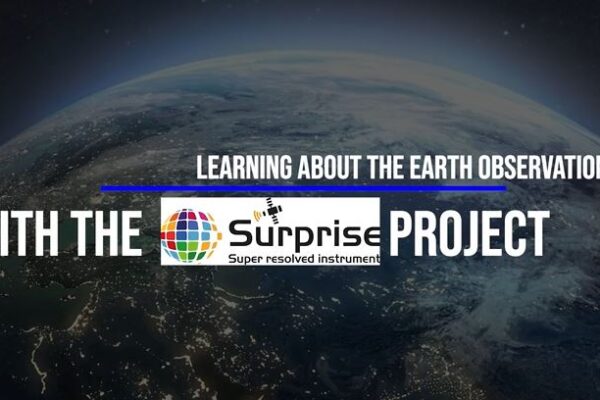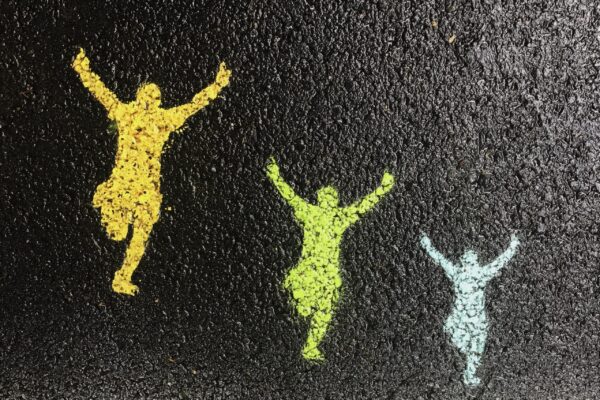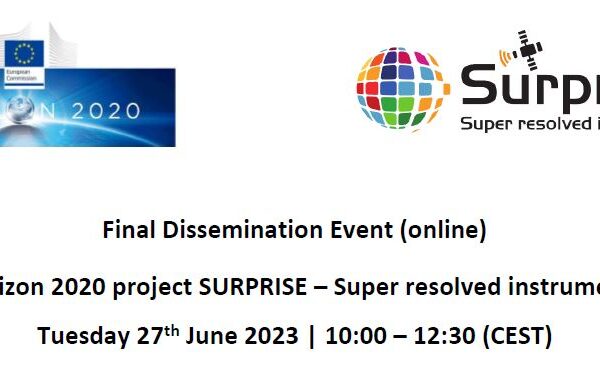The SURPRISE R&I work in Earth Observation
Earth Observation (EO) has many benefits, like its low operation cost, large availability and global continuous coverage. With respect to optical missions, applications are still limited by two main issues: revisit time and spatial resolution. While Low Earth Observation missions can achieve resolutions better than 100 m, their revisit time typically stands at several days, limiting their capacity to monitor dynamic events. Geostationary missions, instead, provide data on an hourly basis, but their spatial resolution is currently limited to 1 km typically, insufficient to fully address local phenomena.
By studying a new concept of instruments with medium spatial resolution and near continuous revisit (hourly), the SURPRISE project aimed to pave the way to a major breakthrough in EO.
SURPRISE’s main objective was to implement a demonstrator of an EO payload – working in the Visible – Near Infrared (VNIR) and in the Medium InfraRed (MIR) and conceived to operate from GEO platform – with enhanced performance in terms of spatial resolution, on-board data processing and encryption functionalities. This goal was achieved by using Compressive Sensing (CS) implemented via a Spatial Light Modulator (SLM) technology.
In SURPRISE, CS and SLM were used to devise a super-resolution architecture used to increase the number of pixels of the image observed by the instrument’s fore-optics, without increasing the number of detector’s elements. The acquisition of several measurements – each corresponding to the integrated value of the image modulated via suitable SLM patterns – is used to reconstruct the super-spectral image with a higher number of pixels. By applying CS techniques, the image can be reconstructed by acquiring a total number of measurements smaller than the number of pixels of the reconstructed image.
CS offers further advantages for handling large amounts of data and fast on-board processing for information extraction, as well as native encryption on top of native compression. SLM technology, at the core of the CS architecture, is also addressed by: reworking commercial SLM and testing current European SLM in relevant environment; outlining a development roadmap for a European SLM suitable for space.
Overall, SURPRISE provided unprecedented insights on the implementation of super-resolved CS EO instrumentation thanks to: the construction of a demonstrator in the VNIR and MIR able to achieve a super-resolution factor of 32×32, the study of a European SLM technology suitable for space and the analysis of the impact of CS instrumentation on EO applications, with an emphasis on fire monitoring and ocean colour.
Overview of main results
The SURPRISE action was structured around 9 interrelated Work Packages (WPs), including the analysis of EO applications and user
requirements, system design, assembly and testing, and exploitation work. Meaningful final results could be achieved thanks to intense work and dedication of the entire project team, jointly working on interrelated research, innovation, dissemination and exploitation activities.
The main results achieved at the end of the SURPRISE action include:
• state-of-the-art CS demonstrator with super-resolution up to 32×32 in the VNIR and MIR;
• detailed studies of SLM diffraction effects in the MIR;
• consolidated procedure for reworking COTS SLM;
• environmental testing on current European SLM technology and feasibility study with development roadmap for a European SLM for space;
• optimised reconstruction algorithms, with analysis to enable native encryption and on-board processing;
• two SURPRISE-like payload concepts, one for fire monitoring and the other for ocean colour – with relevant development roadmap.
Overall, the SURPRISE action has provided substantial insights for improving the capability of future space optical systems in many respects:
• Novel generation of optical systems;
• A new approach to data acquisition, compression and encryption;
• Data processing and computational burden.
Moreover, the action has contributed to strengthening the European scientific and industrial competitiveness in cutting-edge technologies: the demonstrator is presently at the forefront of CS research, while the SLM feasibility study and environmental tests poses a sound basis for European competitiveness in this cutting-edge technology.
Finally, the impact analysis on EO applications showed that the specifications of the SURPRISE-like GEO payload could provide clear benefits for Ocean Colour and Fire Monitoring, mainly in terms of spatial resolution together with revisit time, with potential large benefits for future EO application products, from environmental risk management to scientific investigation of high temperature events, from global change studies to climatological studies.
SURPRISE Publications
Our partners have been busy letting the scientific community know about the project. Take a look at our publications below.
- Raimondi, V. et al. (SURPRISE Consortium), “THE SURPRISE DEMONSTRATOR: A SUPER-RESOLVED COMPRESSIVE INSTRUMENT IN THE VISIBLE AND MEDIUM INFRARED FOR EARTH OBSERVATION”. ESA OBPDC conference (21-23/09/2020 – virtual) – PUBLISHED (download the article here SURPRISE_PaperOBPDC_2020)
- Raimondi, V. et al. (SURPRISE Consortium), “SPATIAL LIGHT MODULATOR-BASED ARCHITECTURE TO IMPLEMENT A SUPER-RESOLVED COMPRESSIVE INSTRUMENT FOR EARTH OBSERVATION”. IGARSS 2021 (11-16/07/2021, Brussels, Belgium) – – PUBLISHED (download the article here SURPRISE_PaperIGARSS_2021)
- Magli, E. et al, “COMPRESSIVE IMAGING AND DEEP LEARNING BASED IMAGE RECONSTRUCTION METHODS IN THE SURPRISE EU PROJECT”, 2nd European Workshop on On-Board Data Processing – OBDP 2021 (14-16/06/2021, Virtual) – PUBLISHED (download the article here SURPRISE_PaperOBDP2021)
- Raimondi, V. et al. (SURPRISE Consortium), COMPRESSIVE SENSING INSTRUMENTAL CONCEPTS FOR SPACE APPLICATIONS. SPIE Photonics Europe 2022 (3-7/04/2022, Strasbourg, France) – PUBLISHED (download the article here SURPRISE_PhotonicsEurope2022)
- Cilia, M., Prette, N., Valsesia, D., Bianchi, T., Magli, E., “DEEP LEARNING METHODS FOR SATELLITE COMPRESSIVE IMAGING”. 8th European Workshop on On-Board Payload Data Compression – OPBDC 2022 (28-30/09/2022, Athens, Greece) – PUBLISHED (download the article here)
- Migliorati, A., Valsesia, D., Bianchi, T., Magli, E., ” JOINT SUPER-RESOLVED COMPRESSIVE SENSING AND ENCRYPTION FOR EARTH OBSERVATION APPLICATIONS”. 8th European Workshop on On-Board Payload Data Compression – OPBDC 2022 (28-30/09/2022, Athens, Greece) – PUBLISHED (download the article here)
- S. Francés González, D. Berndt, G. Borque Gallego, D. Borrelli, U. Dauderstädt, P. Dürr, M. Eckert, J. Heber, D. Kunze, C. Pache, Giuseppe Pilato, V. Raimondi, E. Suetta, H. Torlee, A. Ummel, M. Wagner, Towards a spatial light modulator technology for space applications: performance analysis under the environmental conditions”. International Conference on Space Optics – ICSO 2022 (28-3-8/10/2022, Dubrovnik, Croatia) – PUBLISHED (download the article here)
- Raimondi, V. et al. (SURPRISE Consortium), “Super-resolved compressive demonstrator for Earth Observation applications in the Medium Infrared: instrumental concept, optical design and expected performances”. International Conference on Space Optics – ICSO 2022 (28-3-8/10/2022, Dubrovnik, Croatia) – PUBLISHED (download the article here)
- G. Borque Gallego, L. Giriens, A. Ummel, J.-C. Roulet, D. Guzzi, V. Raimondi, C. Pache, “Front-window replacement and performance characterization of a commercial digital micro-mirror device for use in the infrared spectrum”. International Conference on Space Optics – ICSO 2022 (28-3-8/10/2022, Dubrovnik, Croatia) – PUBLISHED (download the article here)
- T. Bianchi, D. Guzzi, C. Lastri, E. Magli, V. Nardino, L. Palombi, N. Prette, V. Raimondi, D. Valsesia, “Diffraction Efficiency-Aware Reconstruction for Compressive Sensing in the Mid-infrared”. International Geoscience and Remote Sensing Symposium – IGAARS 2023 (16-21/07/2023, Pasadeena, California, USA) – PUBLISHED (download the article here)
- T. Bianchi, M. Cilia, E. Magli, A. Migliorati, N. Prette, D. Valsesia, “Onboard Processing Capabilities of an Earth Observation Compressive Sensing Payload”. International Geoscience and Remote Sensing Symposium – IGAARS 2023 (16-21/07/2023, Pasadeena, California, USA) – PUBLISHED (download the article here)
- A. Gonnelli, S. Baronti, R. Carlà, V. Raimondi, “The impact of spatial resolution on active fire monitoring by 2 multispectral satellite imagery”. International Geoscience and Remote Sensing Symposium – Advanced Infrared Technology and Applications – AITA – 2023 (10-13/09/2023, Venice, Italy) – ACCEPTED (will be available for download soon!)
- Raimondi, V. et al. (SURPRISE Consortium), “Exploring the potential of compressive sensing payloads for Earth Observation from geostationary platform: an instrumental concept for fire monitoring”. International Geoscience and Remote Sensing Symposium – Advanced Infrared Technology and Applications – AITA – 2023 (10-13/09/2023, Venice, Italy) – ACCEPTED (will be available for download soon!)
The first years of the SURPRISE research
How could the SURPRISE project deliver successful final results? Take a look at the progress of our work throughout the years.
- SURPRISE overview at project outset / Kick Off meeting – download here SURPRISE_ProjectStart_KickOff
- SURPRISE video – SURPRISE at 6 months – watch it here
- SURPRISE overview at 12 months – download here SURPRISE_Update_Year1
- SURPRISE video – The SURPRISE research into action – watch it here
- SURPRISE User Requirements – Summary: SURPRISE_D2.1_DeliverableSummary
- SURPRISE Preliminary algorithm – Summary: SURPRISE_D5.1_DeliverableSummary
- SURPRISE Detailed Design Report – Summary: SURPRISE_D4.3_DeliverableSummary
- SURPRISE Detailed Evaluation Report – Summary: SURPRISE_D4.4_DeliverableSummary
- SURPRISE Test Plan Report – Summary: SURPRISE_D4.5_DeliverableSummary
- SURPRISE SLM Prototype Report – Summary: SURPRISE_D3.1_DeliverableSummary
- SURPRISE Optical Assembly – Summary: SURPRISE_D6.1_DeliverableSummary
- SURPRISE Sync Electronics Board and Data Handling System – Summary: SURPRISE_D6.2_D6.4_DeliverableSummary
- SURPRISE Scanning System and Test Equipment (OGSE) – Summary: SURPRISE_D6.3-D6.5_Deliverable Summary




